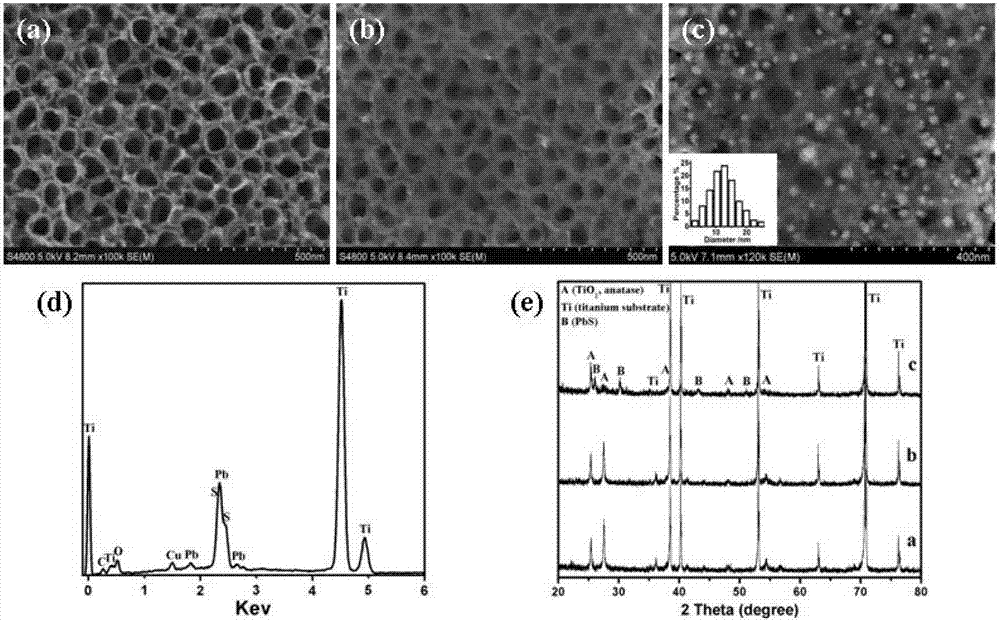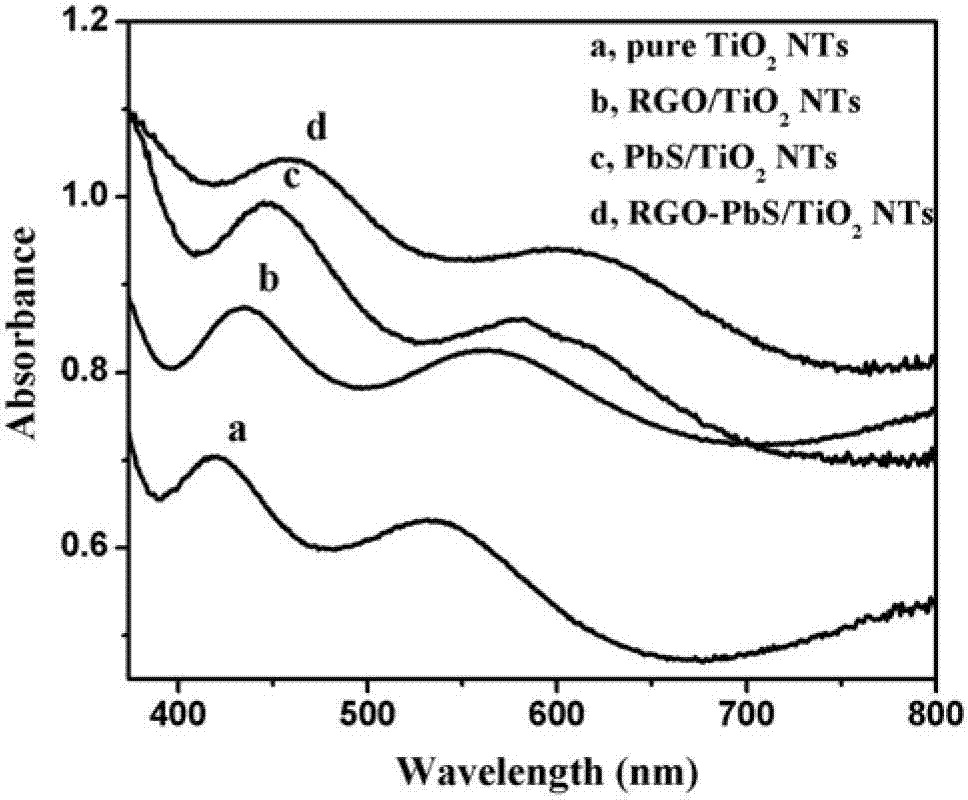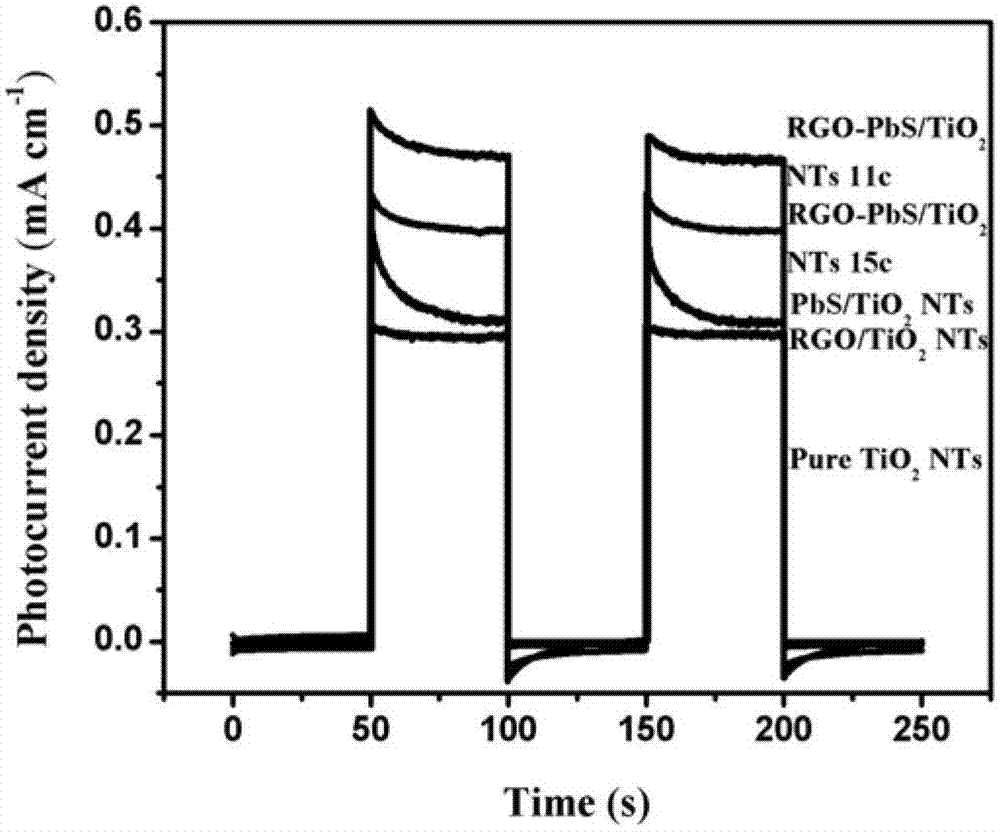Composite photocatalyst, its preparation and application
A technology of catalyst and composite light, which is applied in the field of high-efficiency photocatalytic nanomaterials, novel, and organic wastewater treatment. It can solve the problems of easy recombination of photogenerated electrons and holes, poor adsorption capacity of organic matter, and insufficient specific surface area, so as to improve electron conduction. ability and photoelectric conversion efficiency, enhanced adsorption capacity, and effects of high photoelectric conversion characteristics
- Summary
- Abstract
- Description
- Claims
- Application Information
AI Technical Summary
Problems solved by technology
Method used
Image
Examples
Embodiment 1
[0030] (1) Polishing the surface of the pure titanium base material, cleaning it for later use;
[0031] (2) Preparation of organic electrolyte: the electrolyte is composed of 0.1MNaF and 0.5MNaHSO 4 The composition of the aqueous solution;
[0032] (3) Under 15V DC voltage, with pure titanium sheet as anode and platinum sheet as cathode, titanium oxide nanotubes are electrolyzed in electrolyte;
[0033] (4) Calcining the titanium dioxide nanotube array prepared above under aerobic conditions at 400°C-500°C for more than 3h to crystallize it into TiO 2 array of nanotubes.
[0034] (5) Preparation of graphene-PbS modified titania nanotube arrays:
[0035] Put the above TiO 2 Nanotube arrays were placed in 30ml containing 1mM Pb(NO 3 ) 2 , 1 mM Na 2 S 2 o 3 and 0.4mg mL -1 In the graphene oxide solution, the standard three-electrode system was used to electrodeposit TiO on the CHI 660D electrochemical workstation by cyclic voltammetry. 2 On nanotube arrays, graphene-P...
Embodiment 2
[0039] Graphene-PbS / TiO 2 Nanotube Array Photocatalytic Degradation of Pentachlorophenol
[0040] We use pure TiO 2 Nanotube arrays and modified TiO 2 Nanotube arrays were used to degrade 10mg / L pentachlorophenol wastewater.
[0041] Implementation steps:
[0042]1. Graphene-PbS / TiO with an effective electrode area of 3cm×2cm 2 The composite nanotube array electrode was immersed in 50mL of pentachlorophenol wastewater with a concentration of 10mg / L;
[0043] 2. Use a Xe lamp with a light source of 500W (100mW / cm 2 ), simulating sunlight to photocatalytically degrade it;
[0044] 3. After regular sampling, use a UV-visible spectrophotometer to monitor the change of pentachlorophenol concentration in the solution;
[0045] 4. Control experiment on unmodified TiO 2 Carry out on materials such as nanotube arrays, and the steps are the same as above.
[0046] Figure 4 Curve 1 shows that the direct photolysis efficiency of pentachlorophenol is about 54%. Curve 2 is for...
PUM
 Login to View More
Login to View More Abstract
Description
Claims
Application Information
 Login to View More
Login to View More - R&D
- Intellectual Property
- Life Sciences
- Materials
- Tech Scout
- Unparalleled Data Quality
- Higher Quality Content
- 60% Fewer Hallucinations
Browse by: Latest US Patents, China's latest patents, Technical Efficacy Thesaurus, Application Domain, Technology Topic, Popular Technical Reports.
© 2025 PatSnap. All rights reserved.Legal|Privacy policy|Modern Slavery Act Transparency Statement|Sitemap|About US| Contact US: help@patsnap.com



